Do you know how to check a dog for ticks? If not, it’s time to learn! Integrative veterinarian Dr. Julie Buzby walks you through how to do a comprehensive tick check on your dog so you can help keep your dog safe from ticks.
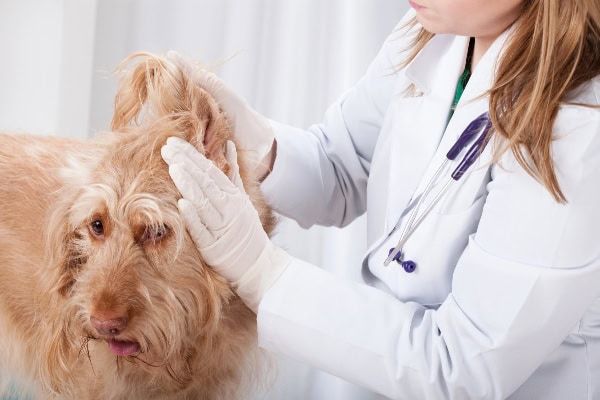
“I’d like to check you for ticks” isn’t just a line from a Brad Paisley song. It’s also something you should say (or sing) to your dog on a regular basis. Dog tick checks are important, especially if you live in an area where ticks are prevalent or if you like to hike or camp with your dog.
Unfortunately, ticks can transmit a variety of serious diseases within 3-48 hours of attaching to your dog and feeding on his or her blood. And ticks are very good at hiding, especially if your dog has thick, long, or dark-colored fur. Thus, dog parents should know how to check a dog for ticks and do so regularly.
What do ticks look like?
Ticks have a flattened oval shape and are dark brown to black before they take in a blood meal. However, an engorged female tick (one that has consumed a large amount of blood) can increase in weight by 100-fold and tends to have a greyish color and swollen appearance.
Immature ticks (larvae and nymphs) are smaller than adults—somewhere around the size of a grain of sand, poppy seed, or freckle, depending on the type of tick and life stage. Adult ticks are closer to the size of an apple seed, or sometime even larger. Larvae also only have six legs. Nymphs and adults have eight legs.
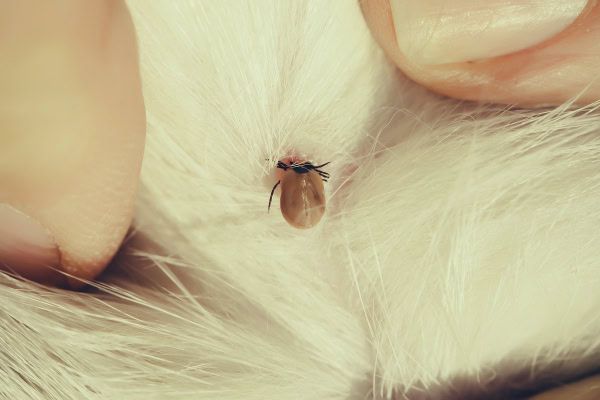
Is it a tick or a nipple, wart, or skin tag?
Sometimes warts, nipples, or skin tags can be mistaken for ticks and vice versa. In order to tell the difference, look closely at the “tick.” If it has six or eight legs, it is a real tick. And if it doesn’t have legs, it is probably not a tick (however, legs can be a bit hard to see on an engorged tick).
Also, move the “tick” slightly to look at how it attaches to the dog’s body. If it has a broad base of attachment, it is probably a nipple or skin tag. Ticks bite the host with their narrow mouthparts, so the body is much larger than the point of attachment.
Taking a picture of the suspected tick can sometimes be helpful too. You can blow it up bigger on your phone screen, compare it to pictures of ticks, or even see what AI thinks it is. Plus, if it is a tick, you can submit it to TickSpotters for identification (more on that in a bit).
If you are unsure whether you have found a tick or not, consult your vet. Don’t try to remove it! You can cause your dog significant discomfort if you try to use tweezers or a tick removal tool to pull off a nipple, wart, or skin tag.
How to check a dog for ticks
When it comes to checking your dog for ticks, it’s helpful to follow the same routine each time. Having a system makes it easier to be thorough and ensures you won’t accidentally miss a spot. You will create your own system in time, but for now I want to share mine with you.
There are specific locations where it is more common for ticks to bite dogs. But it is important that you check every part of your dog. Thus, I like to start the tick check with a full body scan then double check the areas where ticks hide more frequently.
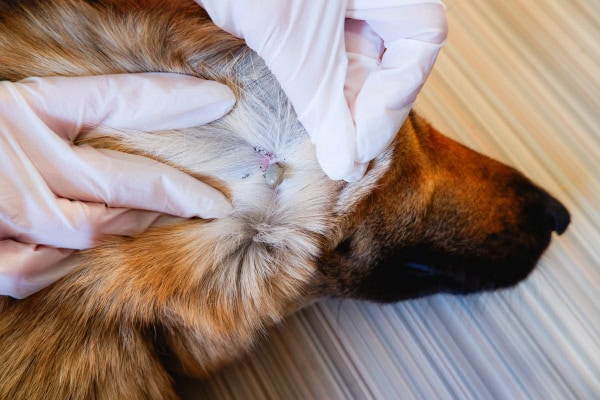
First go over every inch of your dog’s body
Start by gently running your hands over your dog’s entire body, carefully parting the fur all the way down to the skin for a clear view. You can use your fingers or a flea comb to part the hair—whatever works best for you. Ensuring you actually get all the way to the skin is especially important if your dog has long or fluffy fur.
Begin with your dog’s head, then check the neck, back, sides, and rear end. As you move along, visually check for ticks while also feeling for ticks with your hands. (This is also a great time to check your dog’s skin for any abnormal cuts, bumps, lumps, or irritation.)
Next, check along the tail, the outside of the legs, the belly, and the inner sides of the legs. This full-body scan allows you to examine every part of your dog for a tick (or multiple that could be hiding). And it ensures no area is overlooked.
Double check the areas where ticks like to hide
Now you are ready for a more targeted approach. This next step—returning to areas where ticks hide most frequently— is crucial.
Eyes, eyelids, and ears
Once again, start at the head and work your way down. Examine the dog’s nose and near the eyes and eyelids. Ticks sometimes hide in the eyelids or look like a wart or eye discharge, so it is important to pay close attention.
Then look at the ear flap, ear canal, and area around the ear. Ticks may latch on to the outside of the ears or inside the folds of the ears. Sometimes they even move down into the ear canal.
Neck, under the collar, legs, armpits, and groin
Next, check for ticks on the neck and under the collar. As you move along, take a second look at the dog’s back and legs. Pay special attention to the “armpits” or “legpits” of all four legs—this is a favorite hiding spot for ticks.
Feet, toes, and tail
It is also important to inspect each foot, especially the area between each of the toes where ticks love to hide. Finally, investigate the tail area (where the dog’s tail meets the back and under the dog’s tail near the anus).
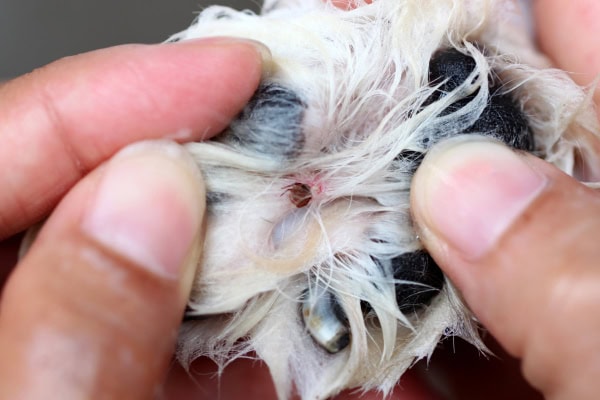
Remove ticks as you find them
Please note that as you are doing this scan, it is best to remove any ticks immediately as you find them. You don’t want to find a tick, make a mental note of its location, and then have to find it a second time to remove it.
To remove the tick, grab a pair of tweezers or a tick removal tool, put on some gloves, and part the dog’s coat to expose the tick. Then grasp the tick as close to the skin with the tweezers as possible. Gently but firmly pull the tick upward in one motion to remove it. (Or follow the instructions on the tick tool to get the tick out of the skin.)
Inspect the bite wound to ensure you removed the whole tick. Then wash the bite, your hands, and the tick tool with warm soapy water and dispose of the tick. I recommend placing the tick in a jar of rubbing alcohol to kill and preserving it in case your vet wants to see it. Identifying the type of tick can help the vet know which tick-borne diseases your dog could have been exposed to.
You could also consider taking a picture of the tick and submitting it to The University of Rhode Island TickSpotters page. The experts there can identify the tick for you, and also will use the information you provide for their tick surveillance programs.
Once you have removed the tick, resume the scan in the location you found the last tick. This helps ensure you don’t miss another tick hiding in the same area. Then move on with the scan from there.
(For more detailed instructions, check out my full article on how to remove a tick from a dog.)
How often should you check a dog for ticks?
I always recommend checking your dog daily for ticks during tick season if you are in a tick-prevalent area. Daily tick checks are especially important if you and your dog have been spending time in bushes or thick grass where ticks are more likely to hide. But remember, ticks can live anywhere. Clients have told me their dog got a tick from going out in the yard or on a short walk.
Don’t forget about tick preventives
In addition to checking your dog for ticks, it is also a good idea to keep your dog on a veterinarian-prescribed tick preventative. These products repel and/or kill ticks, adding another layer of protection against ticks and the diseases they carry.
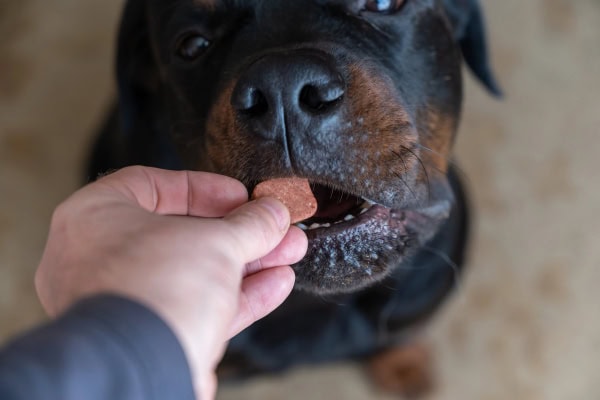
Since Lyme disease in dogs, Ehrlichiosis, Babesiosis, Rocky Mountain spotted fever, and other tick-borne diseases in dogs are spread when the tick feeds on the dog, minimizing the amount of time the tick is attached is key for prevention. This is best accomplished by having your dog on a tick preventive and checking your dog for ticks.
Your veterinarian can help you find the tick preventive product that is right for your dog’s lifestyle and needs. Please talk to your vet about tick preventives rather than buying an over-the-counter product. They may be less expensive than what you get from the vet, but they also tend to be less effective.
The tick-et to checking your dog for ticks
When it comes to checking your dog for ticks, developing your routine and sticking with it is the most important part. It doesn’t really matter if you do the tick check my way or a different way. What matters is that you feel and look at every part of your dog’s body—then go back a second time and check the spots where ticks like to hide. Doing this daily and keeping your dog on tick preventive go far in decreasing the risk of tick-borne disease.
If you have any questions about checking for, removing, or preventing ticks, reach out to your vet. He or she is there to help you help your dog stay healthy and happy.
Do you have any tips for checking your dog for ticks?
Please share them below

